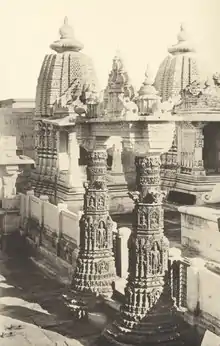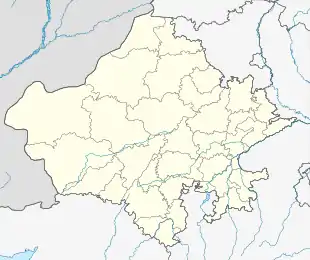Mahavira Jain temple, Osian
The Mahavira Jain temple is built in Osian of Jodhpur District, Rajasthan. The temple is an important pilgrimage of the Oswal Jain community. The temple is visited by both Jain and Hindu.[1]
| Mahavira Jain temple | |
|---|---|
 Mahavira Jain Temple in 1897 | |
| Religion | |
| Affiliation | Jainism |
| Deity | Mahavira |
| Festivals | Mahavir Jayanti |
| Governing body | Anandji Kalyanji Trust |
| Location | |
| Location | Osian, Jodhpur, Rajasthan |
 Location of Mahavira Derasar in Rajasthan | |
| Geographic coordinates | 26°43′28.4″N 72°53′30.4″E |
| Architecture | |
| Style | Gurjara-Pratihara |
| Creator | King Vatsaraja |
| Date established | 783 A.D. |
| Temple(s) | 1 |
History
The Mahavira Temple is an important tirtha for Jains. According to an inscription found at Sachiya Mata Temple dating back to 956 A.D., it was built during the Gurjara-Pratihara dynasty by King Vatsaraja in 783 AD,[2] making it the oldest surviving Jain temple in western India.[3] The temple had its first renovation in 956 AD during the time of Acharya Ratnaprabhasuri.[4] George Michell describes the existing main temple as "mostly 11th century", with parts from the 8th century. The "ornate gateway" is from 1015.[5] The temple was plundered by Muslim rulers, and none of the original idols survived. In 1016 CE, the temple was restored, and a manastambha was constructed.[6] The temple was later renovated in the 12th century.[7] An inscription dating 953 CE found in the temple states that Osian was rich with decorated temples of every caste.[2]
Architecture
The Jain temple is dedicated to Mahavira and belongs to Śvētāmbara sect of Jainism. The temple is considered a testimony of architecture Gurjara-Pratihara dynasty.[8] This a large temple[9] surrounded by enclosing wall consisting of garbhagriha, mandapa. The temple features a sanctum, a closed hall, an open porch and an ornate Torana (gateway) and exquisite sculptures.[10][11] The torana in front of the sanctum is rich with ornate carvings of tirthankaras, 12 in padmasan posture and 4 kayotsarga positions.[12] The pillars of the temple feature intricate artwork are particular Maha-Maru tradition.[10][13] The temple has seven subsidiaries, four on the eastern and three of the western side of the sanctum.[14] These shrines are joined by pradaksinapatha. Eastern parts of the shrine have figures of Mahavira and Parshavanatha.[9] The Shikhara of the garbhagriha and subsidiary shrine are crowned with amalaka and kalasa. The shikhara above mulprasad was constructed later with Māru-Gurjara architecture.[12]
The temple has a large image of Mahavira inside the garbhagriha. The outer and inner walls of the sanctum and closed hall are profusely decorated with carvings of Asta-Dikpalas, yaksha-yakshi, tirthankara, vidyadevi, and other deities. Vidyadevi sculptures are portrayed as playing musical instruments. The northern, southern, western walls of the temple have carvings of Neminatha's life like birth, war, renunciation, etc. The antarala ceiling of every shrine in the temple complex is rich with carvings of flowers.[9] Dev-Kulika temple is also part of the temple complex.[15]
Mahavira temple is the one of the most renowned temple in India.[16] The elobrate architecture is comparable to that Parshvanatha temple, Khajuraho and Ranakpur Jain temple.[6]
Gallery
 Sikhara of the temple
Sikhara of the temple Detailed carving on wall
Detailed carving on wall Temple side view
Temple side view Shikhar
Shikhar Carving of Parshvanath on wall
Carving of Parshvanath on wall Pillars in Jaina temple Osia in India 1897
Pillars in Jaina temple Osia in India 1897 A crowned and jewelled figure of a Jain savior or saint.
A crowned and jewelled figure of a Jain savior or saint.
Conservation
The temple is protected by Archaeological Survey of India.[17]
See also
| Wikimedia Commons has media related to Mahavira Jain temple, Osian. |
Reference
Citation
- Weisgrau & Henderson 2016, p. 166.
- Kalia 1982, p. 2.
- Cort 1998, p. 112.
- Cort 1998, p. 133.
- Michell 1990, p. 302.
- Titze 1998, p. 152.
- Kalia 1982, p. 3.
- Singh & Lal 2003, p. 1043.
- Kalia 1982, p. 4.
- Brown 2013, p. 405.
- The Hindu & Temples of peace.
- Kalia 1982, p. 5.
- Neubauer 1981, p. 34.
- Vasavada 2001.
- Kumar 2001, p. 54.
- Jain 2009, p. 283.
- Protected Monuments in Rajasthan.
Source
- Brown, Percy (2013), Indian Architecture (Buddhist and Hindu Period), Read Books Ltd, ISBN 9781447498575
- Cort, John E. (1998), Open Boundaries: Jain Communities and Cultures in Indian History, SUNY Press, ISBN 9780791437865
- Jain, Arun Kumar (2009), Faith & Philosophy of Jainism, Gyan Publishing House, ISBN 9788178357232, retrieved 23 September 2017
- Kalia, Asha (1982), Art of Osian Temples: Socio-economic and Religious Life in India, 8th-12th Centuries A.D., Abhinav Publications, ISBN 9780391025585
- Kumar, Sehdev (2001), A Thousand Petalled Lotus: Jain Temples of Rajasthan : Architecture & Iconography, Abhinav Publications, ISBN 9788170173489
- Michell, George (1990), The Penguin Guide to the Monuments of India: Buddhist, Jain, Hindu, 1, Penguin Books, ISBN 9780670806966
- Neubauer, Jutta Jain (1981), The Stepwells of Gujarat: In Art-historical Perspective, Abhinav Publications, ISBN 9780391022843
- Titze, Kurt (1998), Jainism: A Pictorial Guide to the Religion of Non-Violence (2 ed.), Motilal Banarsidass, ISBN 978-81-208-1534-6
- Singh, Kumar Suresh; Lal, Rajendra Behari (2003), Gujarat, People of India, 22, Popular Prakashan, ISBN 978-81-799-1106-8
- Weisgrau, Maxine; Henderson, Carol (2016), Raj Rhapsodies: Tourism, Heritage and the Seduction of History, Routledge, ISBN 9781317071624
- "Protected Monuments in Rajasthan". Archaeological Survey of India.
- Behl, Benoy K. (1 August 2008). "Temples of peace". The Hindu.
- Vasavada, Rabindra (2001). "Temple of Mahavira Osiaji". Lalbhai Dalpatbhai Museum. Monograph Series on Historic Temples. Ahmedabad.
Further reading
- Vasavada, Rabindra J., Temple of Mahavira Osiaji, 2001, L. D. Institute of Indology, fully online